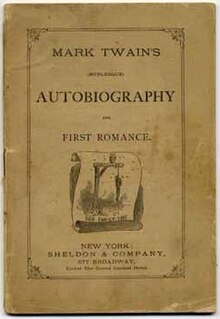
Adventures of Huckleberry Finn is a picaresque novel by American author Mark Twain that was first published in the United Kingdom in December 1884 and in the United States in February 1885.
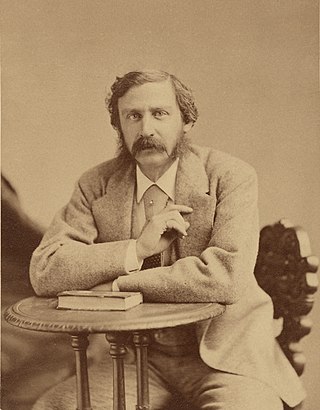
Bret Harte was an American short story writer and poet best remembered for short fiction featuring miners, gamblers, and other romantic figures of the California Gold Rush. In a career spanning more than four decades, he also wrote poetry, plays, lectures, book reviews, editorials, and magazine sketches.

Samuel Langhorne Clemens, known by the pen name Mark Twain, was an American writer, humorist, and essayist. He was praised as the "greatest humorist the United States has produced," with William Faulkner calling him "the father of American literature." Twain's novels include The Adventures of Tom Sawyer (1876) and its sequel, Adventures of Huckleberry Finn (1884), with the latter often called the "Great American Novel." He also wrote A Connecticut Yankee in King Arthur's Court (1889) and Pudd'nhead Wilson (1894) and cowrote The Gilded Age: A Tale of Today (1873) with Charles Dudley Warner.
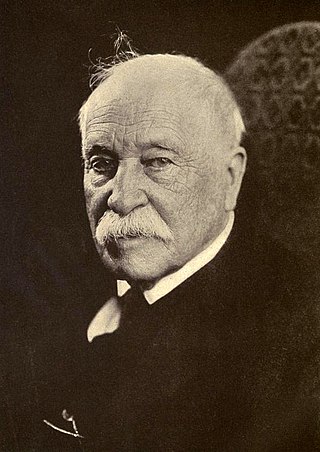
William Dean Howells was an American realist novelist, literary critic, and playwright, nicknamed "The Dean of American Letters". He was particularly known for his tenure as editor of The Atlantic Monthly, as well as for the novels The Rise of Silas Lapham and A Traveler from Altruria, and the Christmas story "Christmas Every Day," which was adapted into a 1996 film of the same name.

Heather Renée Sweet, known professionally as Dita Von Teese, is an American vedette, burlesque dancer, model, actress, and businesswoman. She is credited with re-popularizing burlesque performance, earning the moniker "Queen of Burlesque".

Ruskin Bond is an Indian author. His first novel, The Room on the Roof, published in 1956, received the John Llewellyn Rhys Prize. Bond has authored more than 500 short stories, essays, and novels which includes 69 books for children. He was awarded the Sahitya Akademi Award in 1992 for Our Trees Still Grow in Dehra. He was awarded the Padma Shri in 1999 and Padma Bhushan in 2014.

"The Celebrated Jumping Frog of Calaveras County" is an 1865 short story by Mark Twain. It was his first great success as a writer and brought him national attention. The story has also been published as "Jim Smiley and His Jumping Frog" and "The Notorious Jumping Frog of Calaveras County". In it, the narrator retells a story he heard from a bartender, Simon Wheeler, at the Angels Hotel in Angels Camp, California, about the gambler Jim Smiley. The narrator describes him: "If he even seen a straddle bug start to go anywheres, he would bet you how long it would take him to get to wherever he going to, and if you took him up, he would foller that straddle bug to Mexico but what he would find out where he was bound for and how long he was on the road."

The Personal Memoirs of U. S. Grant are an autobiography, in two volumes, of Ulysses S. Grant, the 18th President of the United States. The work focuses on his military career during the Mexican–American War and the American Civil War. The volumes were written in the last year of Grant's life, amid increasing pain from terminal throat cancer and against the backdrop of his personal bankruptcy at the hands of an early Ponzi scheme. The set was published by Mark Twain shortly after Grant's death in July 1885.
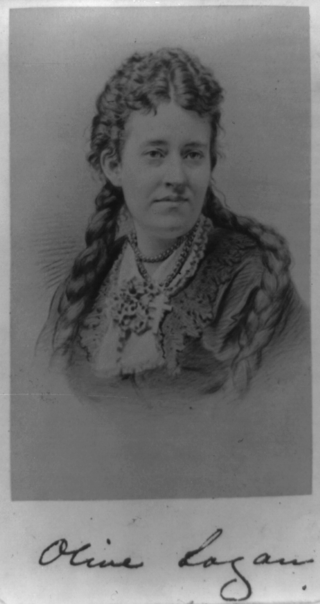
Olive Logan was an American actress and author, daughter of Irish-American actor and playwright Cornelius Ambrosius Logan and Eliza Akeley.
Richard Henzel is a Chicago-based stage, film, TV, and voice-over actor.

"Eve's Diary" is a comic short story by Mark Twain. It was first published in the 1905 Christmas issue of the magazine Harper's Bazaar, in book format as one contribution to a volume entitled "Their Husband's Wives" and then in June 1906 as a standalone book by Harper and Brothers publishing house.
John Camden Hotten was an English bibliophile and publisher. He is best known for his clandestine publishing of numerous erotic and pornographic titles.

Olivia Susan Clemens was the second child and eldest daughter of Samuel Clemens, who wrote under the pen name Mark Twain, and his wife Olivia Langdon Clemens. She inspired some of her father's works, at 13 wrote her own biography of him, which he later published in his autobiography, and acted as a literary critic. Her father was heartbroken when she died of spinal meningitis at age 24.

The $30,000 Bequest and Other Stories (1906) is a collection of thirty comic short stories by the American writer Mark Twain. The stories contained span the course of his career, from "Advice to Young Girls" in 1865 to the titular tale in 1904. Although Twain had ample time to refine his short stories between their original publication date and this collection, there is little evidence to suggest he took an active interest in doing so. "A Burlesque Biography" contains only a few minor technical revisions which make it different from the 1871 version found in Mark Twain's "(Burlesque) Autobiography and First Romance". "Advice to Little Girls" shows slight revision from its earlier publication in The Celebrated Jumping Frog of Calaveras County.
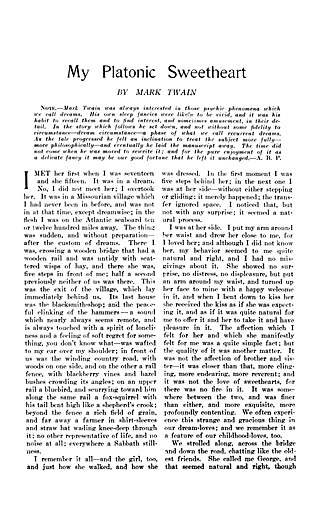
"My Platonic Sweetheart" is a short dream narrative written by American writer Mark Twain. It was originally titled "The Lost Sweetheart" and written during July and August 1898. It was published more than two years after Twain's death, in the December 1912 issue of Harper's Magazine. The main character has several dreams throughout his life about the same woman. The narrative depicts five of these dreams, and in each dream the main character and the woman take on different names. The woman's appearance also changes in each dream. However, the characters' ages in the dreams remain the same, he is seventeen and she is fifteen, and the two characters never fail to recognize each other.

Samuel Langhorne Clemens , well known by his pen name Mark Twain, was an American author and humorist. Twain is noted for his novels Adventures of Huckleberry Finn (1884), which has been called the "Great American Novel," and The Adventures of Tom Sawyer (1876). He also wrote poetry, short stories, essays, and non-fiction. His big break was "The Celebrated Jumping Frog of Calaveras County" (1867).

The Chymical Wedding of Christian Rosenkreutz is a German book edited in 1616 in Strasbourg. Its anonymous authorship is attributed to Johann Valentin Andreae. The Chymical Wedding is often described as the third of the original manifestos of the mysterious "Fraternity of the Rose Cross" (Rosicrucians), although it is markedly different from the Fama Fraternitatis and Confessio Fraternitatis in style and in subject matter.

Henry Martyn Whitney was an early journalist in the Kingdom of Hawaii. Born of early missionaries, he became the first postmaster and founded several long-lasting newspapers.

The use of the pen name of Mark Twain first occurred in Samuel Clemens's writing while in the Nevada Territory which he had journeyed to with his brother. Clemens/Twain lived in Nevada from 1861 to 1864, and visited the area twice after leaving. Historians such as Peter Messent see Clemens's time in Nevada as "the third major formative period of Mark Twain's career" due to his encounters with "writers and humorists who would both shape and put the finishing touches on his literary art." The Routledge Encyclopedia of Mark Twain states that despite the few "disagreeable experiences" he had there, Twain "thrived in Nevada." Among those things he learned was "how far he could push a joke", a lesson learned from some "disagreeable experiences" he brought upon himself.
Chapters from My Autobiography are 25 pieces of autobiographical work published by American author Mark Twain in the North American Review between September 1906 and December 1907. Rather than following the standard form of an autobiography, they comprise a rambling collection of anecdotes and ruminations. Much of the text was dictated.
